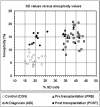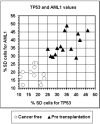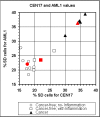The aberrant asynchronous replication - characterizing lymphocytes of cancer patients - is erased following stem cell transplantation
- PMID: 20497575
- PMCID: PMC2887401
- DOI: 10.1186/1471-2407-10-230
The aberrant asynchronous replication - characterizing lymphocytes of cancer patients - is erased following stem cell transplantation
Abstract
Background: Aberrations of allelic replication timing are epigenetic markers observed in peripheral blood cells of cancer patients. The aberrant markers are non-cancer-type-specific and are accompanied by increased levels of sporadic aneuploidy. The study aimed at following the epigenetic markers and aneuploidy levels in cells of patients with haematological malignancies from diagnosis to full remission, as achieved by allogeneic stem cell transplantation (alloSCT).
Methods: TP53 (a tumor suppressor gene assigned to chromosome 17), AML1 (a gene assigned to chromosome 21 and involved in the leukaemia-abundant 8;21 translocation) and the pericentomeric satellite sequence of chromosome 17 (CEN17) were used for replication timing assessments. Aneuploidy was monitored by enumerating the copy numbers of chromosomes 17 and 21. Replication timing and aneuploidy were detected cytogenetically using fluorescence in situ hybridization (FISH) technology applied to phytohemagglutinin (PHA)-stimulated lymphocytes.
Results: We show that aberrant epigenetic markers are detected in patients with hematological malignancies from the time of diagnosis through to when they are scheduled to undergo alloSCT. These aberrations are unaffected by the clinical status of the disease and are displayed both during accelerated stages as well as in remission. Yet, these markers are eradicated completely following stem cell transplantation. In contrast, the increased levels of aneuploidy (irreversible genetic alterations) displayed in blood lymphocytes at various stages of disease are not eliminated following transplantation. However, they do not elevate and remain unchanged (stable state). A demethylating anti-cancer drug, 5-azacytidine, applied in vitro to lymphocytes of patients prior to transplantation mimics the effect of transplantation: the epigenetic aberrations disappear while aneuploidy stays unchanged.
Conclusions: The reversible nature of the replication aberrations may serve as potential epigenetic blood markers for evaluating the success of transplant or other treatments and for long-term follow up of the patients who have overcome a hematological malignancy.
Figures






Similar articles
-
Replication timing aberrations and aneuploidy in peripheral blood lymphocytes of breast cancer patients.Neoplasia. 2010 Aug;12(8):668-74. doi: 10.1593/neo.10568. Neoplasia. 2010. PMID: 20689761 Free PMC article.
-
Granulocyte colony-stimulating factor generates epigenetic and genetic alterations in lymphocytes of normal volunteer donors of stem cells.Exp Hematol. 2004 Jan;32(1):122-30. doi: 10.1016/j.exphem.2003.09.007. Exp Hematol. 2004. PMID: 14725909
-
Allele-specific replication associated with aneuploidy in blood cells of patients with hematologic malignancies.Cancer Genet Cytogenet. 2002 Dec;139(2):97-103. doi: 10.1016/s0165-4608(02)00610-6. Cancer Genet Cytogenet. 2002. PMID: 12550768
-
Detection of numerical aberrations in hematologic neoplasias by fluorescence in situ hybridization.Haematologica. 1997 Jan-Feb;82(1):85-90. Haematologica. 1997. PMID: 9107092 Review.
-
Modes of action of the DNA methyltransferase inhibitors azacytidine and decitabine.Int J Cancer. 2008 Jul 1;123(1):8-13. doi: 10.1002/ijc.23607. Int J Cancer. 2008. PMID: 18425818 Review.
Cited by
-
Replication Timing Aberration of KIF14 and MDM4 / PI3KC 2 β Alleles and Aneuploidy as Markers of Chromosomal Instability and Poor Treatment Response in Ewing Family Tumor Patients.Glob Med Genet. 2023 Apr 21;10(2):54-62. doi: 10.1055/s-0043-1768238. eCollection 2023 Jun. Glob Med Genet. 2023. PMID: 37091312 Free PMC article.
-
Replication timing aberrations and aneuploidy in peripheral blood lymphocytes of breast cancer patients.Neoplasia. 2010 Aug;12(8):668-74. doi: 10.1593/neo.10568. Neoplasia. 2010. PMID: 20689761 Free PMC article.
-
Epigenetic analyses in blood cells of men suspected of prostate cancer predict the outcome of biopsy better than serum PSA levels.Clin Epigenetics. 2011 Aug;2(2):383-388. doi: 10.1007/s13148-011-0029-3. Epub 2011 Mar 29. Clin Epigenetics. 2011. PMID: 21949550 Free PMC article.
-
DNA replication timing, genome stability and cancer: late and/or delayed DNA replication timing is associated with increased genomic instability.Semin Cancer Biol. 2013 Apr;23(2):80-9. doi: 10.1016/j.semcancer.2013.01.001. Epub 2013 Jan 14. Semin Cancer Biol. 2013. PMID: 23327985 Free PMC article. Review.
-
Spontaneous ATM Gene Reversion in A-T iPSC to Produce an Isogenic Cell Line.Stem Cell Reports. 2015 Dec 8;5(6):1097-1108. doi: 10.1016/j.stemcr.2015.10.010. Epub 2015 Nov 19. Stem Cell Reports. 2015. PMID: 26677768 Free PMC article.
References
Publication types
MeSH terms
Substances
LinkOut - more resources
Full Text Sources
Research Materials
Miscellaneous

